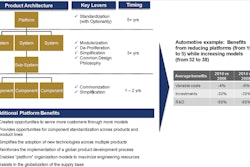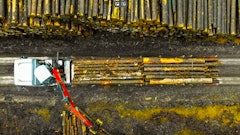Forecasting equipment markets is an art as much as it is a science. It's possible to extend and plot long term trend lines with mathematical formulas. The real problem is estimating what the market will do in the short term, one year out. Estimating what will happen during the next year requires dividing product markets into the smallest possible chunks and making estimates as to what those chunks are going to do; will they go up, down or sideways and what influence will they have equipment sales?
The factors I'm thinking about these days include the following:
Metal commodities: Until a few months ago we were sure that metal commodity markets would remain strong. Since then iron and copper prices have pulled back to the point where some metal producers have scaled back the size of projects or cancelled some altogether.
Coal and gas: I was also pretty sure that the coal market would remain firm. However, recent disruptions in the coal market caused by low prices of shale gas have put into question the long term viability of coal used to generate electricity. Coal mining companies are cutting back production and laying off workers. Compounding the problem is the abundance of shale gas that has caused gas prices to drop which in turn has slowed down new shale gas fracking projects.
Federal Reserve: The Federal Reserve has added the unemployment level to its list of things to worry about. Unemployment among construction workers is more than twice the national total – 17.6% in the latest month. Residential construction usually represents 50% of the entire construction market. Today it is only about 30% of the total. The Fed has decided to try and stimulate the housing market in order to reduce unemployment. It just announced it will start purchasing mortgage-backed securities at a rate of $40 billion per month and put them on its balance sheet. Shifting assets to the Fed’s balance sheet is called “quantitative easing.” This is the third such effort and is referred to as QE3 by the financial press.
Housing market claws back: The housing market has a huge impact on the overall economy. It represents approximately 50% of total construction spending. The slump in the housing market is a major cause of the tepid quarterly GDP numbers. Housing experts believe that 1.2 million of annual housing starts per year is the amount necessary to accommodate new family formations, accommodate new immigrants and replace dilapidated housing. The total number of annual housing starts is improving but has remained below 800,000 units, mostly because of the huge overhang of foreclosures that have kept downward pressure on home prices. Low home prices have made it difficult for people to “move-up” to the next size of house because they can’t sell the one they presently occupy. Existing home sales have also improved, as have home prices. However, prices and sales need to improve considerably more in order to work off the foreclosure inventory and stimulate new housing starts.
Government sponsored road program: Congress finally agreed to pass Moving Ahead for Progress in the 21st Century (aka, MAP-21), a two-year roads and transportation bill. Previously Congress was not able to agree on a road bill, so passed a long series of two-month extensions on the previous ICETEA-LU, which was a six-year bill. The short term nature of the extensions made it impossible for states to commit to large, long-term projects. As a result, many state road programs were shut down for most of the past two years. MAP-21 consolidates a number of earlier programs, eliminates earmarks and expedites projects. Federally sponsored road bills have been proven to create jobs. Federal money spent on roads is said to have a multiplier effect. A rule-of-thumb is that every billion dollars of Federal money spent results in approximately 30,000 new jobs and somewhere between $100 million and $300 million of new equipment sales.
Politics: Presidential election years make forecasting particularly interesting. The incumbent usually has a spending advantage. He can hold back money from previous years and unleash it in key states. As far as I can tell, that has not been the case in this election cycle, probably because so much money was spent in the early part of President Obama’s term to bail out automobile companies, prop up public employee pensions and for the stimulus package with the so-called "shovel-ready" projects. High unemployment makes this a particularly problematic election for Obama. In the past, control of spending programs has given presidential incumbents a distinct advantage.
Emission regulations: The U.S. EPA Tier 4 Interim regulations began on January 1, 2012. The EPA mandated considerably lower toxic emissions for diesel engines. Equipment manufacturers have struggled to conform. Some manufacturers have been able to continue producing and selling machines with Tier 3 engines in them because of the accumulated EPA credits they can apply this year. However, in general, new machines sold since the first of the year have the Tier 4 Interim engines and are more expensive to purchase as well as to operate. The high cost of the EPA rules pulled some equipment purchases into 2011 thereby taking away some sales volume from 2012, though how much is still uncertain. A fairly high percentage of equipment users rented equipment in 2012 because of the economic uncertainty but also because they wanted to avoid purchasing Tier 4 machines.
I will be following all of the economic factors I’ve discussed here as well as many others and by this time next month I’ll load them all into my calculus equation and forecast how 2012 will end up and give you my opinion about 2013 in this column next month.



![Hcm Ax Landcros Press Release[32] jpg](https://img.oemoffhighway.com/mindful/acbm/workspaces/default/uploads/2025/11/hcmaxlandcros-press-release32jpg.mAEgsolr89.jpg?auto=format%2Ccompress&fit=crop&h=100&q=70&w=100)







![Hcm Ax Landcros Press Release[32] jpg](https://img.oemoffhighway.com/mindful/acbm/workspaces/default/uploads/2025/11/hcmaxlandcros-press-release32jpg.mAEgsolr89.jpg?ar=16%3A9&auto=format%2Ccompress&fit=crop&h=135&q=70&w=240)







